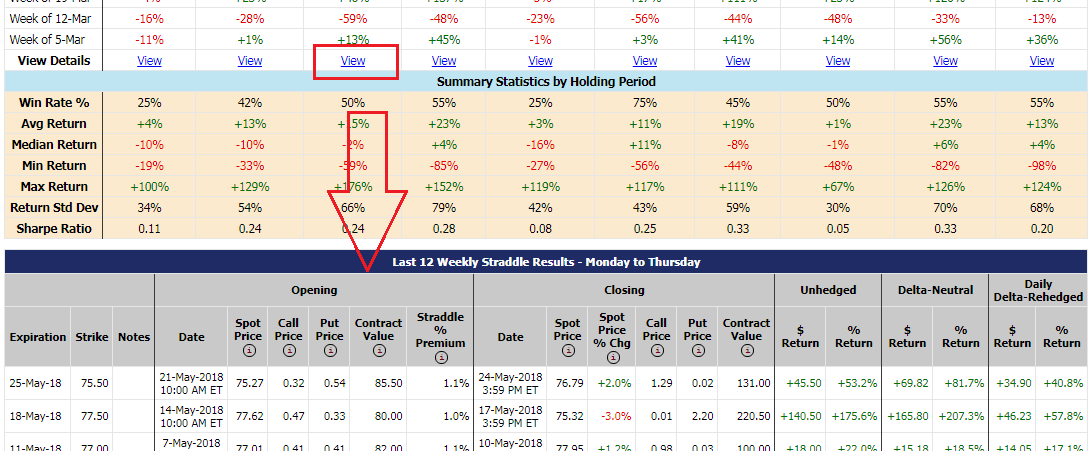The Symbol ATM Straddle Performance History is designed to help you compare at-the-money option straddle results for multiple different holding periods, on a week-by-week basis. Each symbol shows up to the last 12 weeks of ATM straddle returns, for a range of different holding periods -- like Monday-to-Tuesday, Monday-to-Friday, Tuesday-to-Wednesday, etc.
Ideally a trader would use the analysis to enhance their options trading research and help generate ideas for positions to take on at-the-money option straddles. The report is fully functional for both Premium Total Access and Options Trader subscribers.
When you're viewing a symbol's overview page, there is a menu item to the left hand side called ATM Straddle Performance, listed under Tools

The report deals directly with at-the-money option straddles. If you are not familiar with straddles, you can learn about them here .
At a base level, the report tries to answer the question: If I bought a straddle on a certain day of the week and held it until the close of a different day, how often would that straddle gain value?
To do this, what we do is sort through millions of option market snapshots to find the value of option straddles at the open of each week day (typically about 30 minutes after the open to allow the markets to tighten with trading). Then, we track the value of those straddles as they reach the close of each day of the week. Each holding period in the analysis has a start day and an end day -- so if you're looking at Monday-to-Tuesday holding, that would be "opening" on Monday morning and "closing" on Tuesday afternoon. If the straddle gains value over that time frame, that would be considered a "win" for that period. The analysis shows you which holding periods have the highest "win" rates over the course of the last 12 weeks (if available).
If there are exchange holidays on either the start date or the end date, or if the market is too wide to produce an accurate calculation of the value, we will skip the analysis for that observation. We want to focus in on useful observations, where the bid and ask of the options is tight enough to determine a realistic market value for the straddle.
An important concept that goes hand-in-hand with option trading is delta-hedging. To learn more about delta, visit this page. To learn more extensively about delta-neutral trading, visit this page.
Unhedged ATM Straddle is a naked option straddle, 1 call and 1 put on the same at-the-money strike, with no additional stock traded. The resultant value is based solely on the value of the options themselves. Any net delta made from the trade is left untouched.
Delta-Neutral ATM Straddle is based on hedging the straddle's initial net delta to neutral, and then leaving the trade untouched for the remainder of the week.
Daily Delta-Rehedging is based on hedging the net delta both initially at the "opening" of the trade, and then daily at the end of each day to neutralize the delta.
For techniques that include delta-hedging, the straddle return and the win rate would both be affected by the gain or loss in value of the underlying stock that results from hedging.
Below is a screenshot of where you can toggle between these choices on the report.


To view a more detailed breakdown of week-by-week results for one particular holding period, click on the link that says View in the column for that holding period. At the bottom of the page you'll see another table with the details of each week's start values and end values, with more specific results than the summary table above.
This table shows you the Expiration and Strike for the specified straddle, and compares the "Opening" values to the "Closing" values. You can see Notes, which would indicated whether there was an earnings date sometime within the week specified. Towards the right of the table you'll see the different returns based on the available hedging techniques used. $ Return shows the raw return in the strategy based on dollars (the theoretical trade assumes the purchase of 1 long call and 1 long put), while the % Return shows that value in terms of percentage of initial straddle cost.
